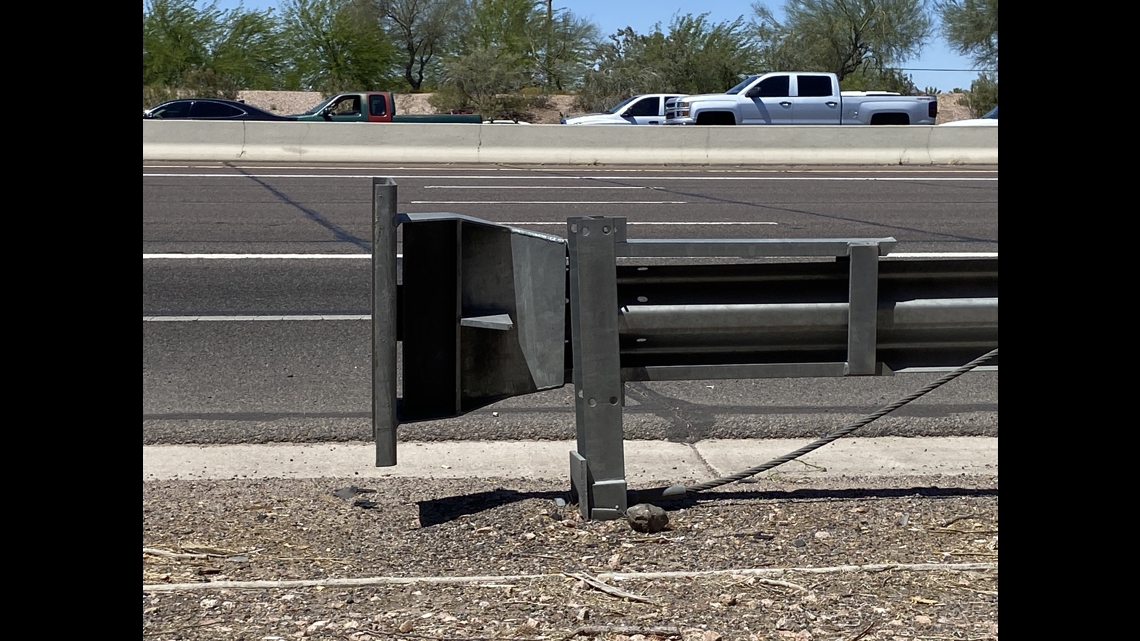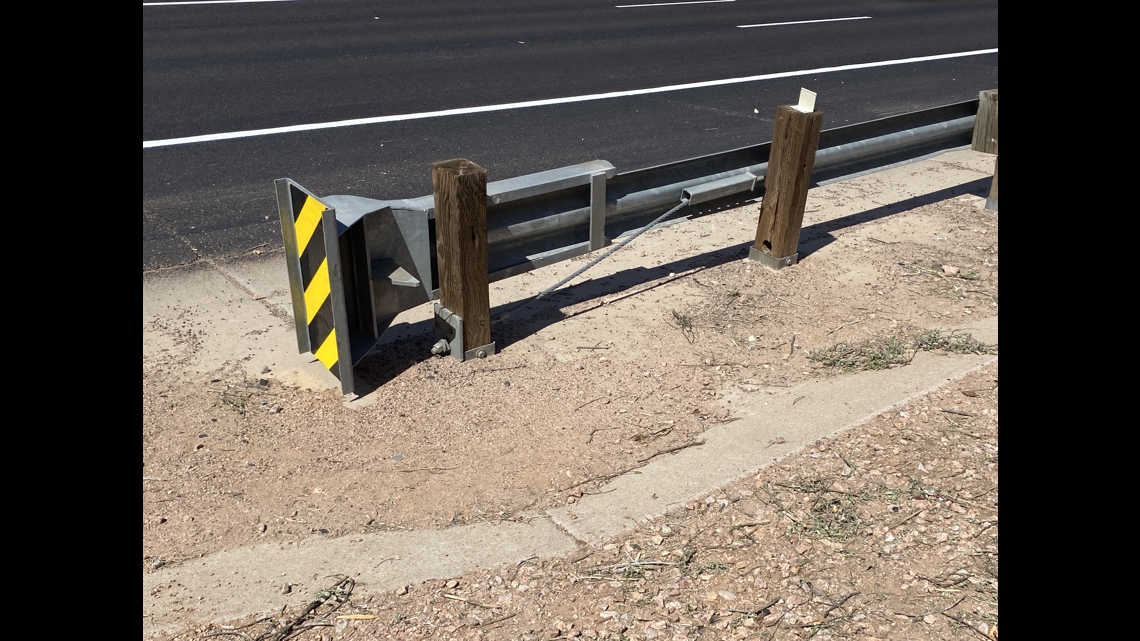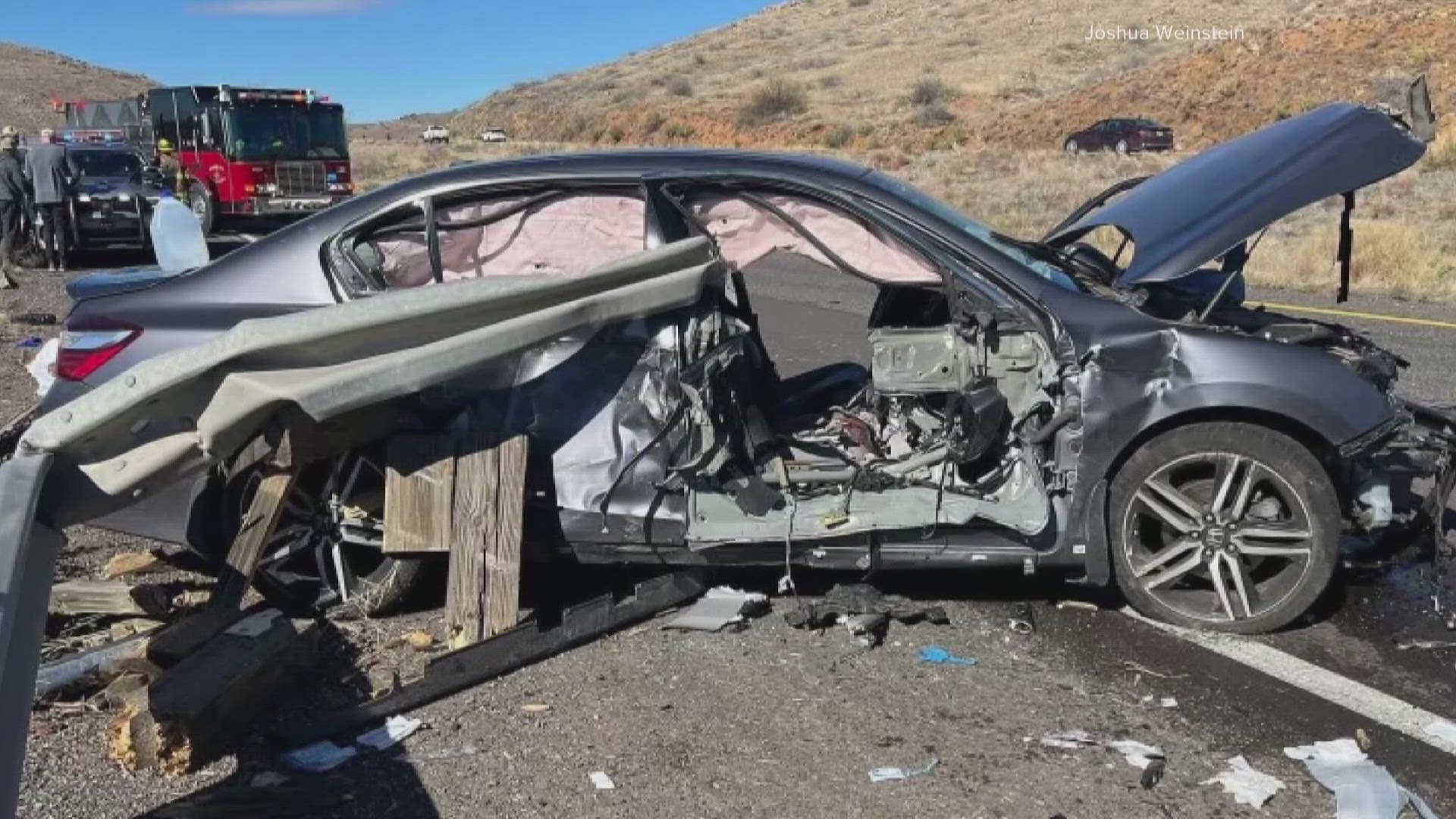PHOENIX — Along I-10 and Loop 202 near Downtown Phoenix... on the right-hand side of the US-60 in Mesa.
These are just a few locations where data obtained by 12News shows more than 4,000 controversial guardrails, called ET-Plus, remain on Arizona roads.
The Arizona Department of Transportation only replaces them if they are damaged or during new construction.
In a 2015 class action lawsuit out of Missouri that was just settled in 2022, attorneys claimed a design flaw in the ET-Plus.
“Instead of ribboning away from the vehicle, the guardrail spears or pierces the vehicle, or causes the vehicle to vault, rollover, or redirect in other unintended ways, thus resulting in serious injury or death to vehicle occupants and others,” the suit claims.
A settlement agreement required the guardrail's manufacturer to pay to find and replace the guardrails in Missouri. Now, a teen who lost his leg in a crash with one of the guardrails near Cordes Junction wants the same to happen in Arizona.
'The problem is known'
One of the guardrails stood along I-17, south of Cordes Junction, where two teens crashed into it in February. Jaxson Elliot died in the crash and Jett Weinstein lost his right leg.
MORE INFORMATION: Valley teen injured in deadly guardrail crash recovering at home
“Just remember it coming through the car like this,” Weinstein said, sweeping his hand in front of his body.


Weinstein was in the passenger seat and Elliot was driving.
“It made me angry because, you know, the problem is known by Trinity,” John Schirger, an attorney with Schirger Feierabend LLC out of Kansas City, Missouri, said.
Schirger and Patrick Stueve, with Stueve Siegel Hanson LLP, filed a class action lawsuit against Trinity Industries, the maker of the ET-Plus, in Missouri.
“The accident that happened in February in your city is exactly what, you know, Pat and I were fighting for the whole time to try to prevent - what we warned people about,” Schirger said.
Settlement over controversial guardrail pays to find, replace ET-Plus guardrails in Missouri
In the class action lawsuit, the attorneys claimed there was a design flaw in the ET-Plus.
“Instead of behaving as it should, it locks up,” Schirger said. “And that guardrail then becomes a knife or a missile into the vehicle, right through the engine block, right into the passenger compartment, killing people or taking limbs.”
Trinity agreed to a $56 million settlement in 2022 over the suit. Trinity did not admit fault as part of the settlement agreement, however, Trinity did agree to pay to find and replace the ET-Plus guardrail end terminals on Missouri roads.
“I would like them all to be changed, fixed to be able to save people not hurt them,” Weinstein said of the ET-Plus end terminals still on Arizona roads.
In a statement to 12News about the ET-Plus and the crash involving Weinstein and Elliott, a Trinity Industries spokesperson said they "stand by" the ET-Plus:
The ET-Plus is the most tested highway safety product of its kind. The Federal Highway Administration continuously approved the product for use and has repeatedly confirmed that the ET-Plus meets all applicable safety performance criteria. Trinity stands by the ET-Plus, but at this time, it would not be appropriate to comment regarding an ongoing crash investigation.


In 2014, the Federal Highway Administration began an investigation into the ET-Plus, ultimately finding it meets “applicable safety criteria.”
During the investigation, ADOT announced that it had removed the ET-Plus from the agency’s approved products list. No additional ET-Plus end terminals have been installed on Arizona roads but 4,184 remain on Arizona’s roads.
ADOT is not replacing guardrails unless they're damaged or during new construction
“I would love to be able to understand why somebody thought it was a good decision to no longer approve these end caps going forward, but think that there isn’t a problem with the 4,184 existing ones,” James Fucetola, the attorney with Slavicek Law Firm representing Weinstein said.
ADOT declined 12News’ requests for an interview specifically related to the ET-Plus end terminals on Arizona roads and the February crash.
However, in a written statement a spokesperson said the department follows Federal Highway Administration and the American Association of State Highway and Transportation Officials (AASHTO) guidelines when maintaining state highways and guardrails, which includes replacing them, “when they are struck, when there is a project in that area, or when our employees who travel the highway system everyday notice issues.”
“Continuing to use end terminals that met standards when they were installed and replacing them for reasons noted above follows FHWA and AASHTO standards,” a spokesperson added in the written statement.
'Let's hold them accountable'
12News asked Governor Katie Hobbs if she’d put money in the state budget to replace some or all of the controversial guardrails.
“It’s something I have to look more at overall in our budget. We are prioritizing Arizonans’ health and safety and that’s an important piece of it,” Hobbs said.
While the spokesperson said in the statement that ADOT’s maintenance budget covers replacing struck-end terminals, the spokesperson did not directly answer 12News’ question if ADOT has requested money be put into the state budget to replace the remaining ET-Plus end terminals on Arizona roads.
“I would want ADOT, again, to accept my invitation to sit down urgently and figure out a plan to fix this problem,” Fuecetola said. “It’s a known problem. Let’s have Trinity, or now Valtir, fix the problem as they were forced to do in Missouri. And if - as I suspect they won’t agree to that, let’s hold them accountable.”


In an interview last summer about guardrails on Arizona’s roads, ADOT’s State Engineer Deputy Director Greg Byres echoed ADOT’s statement that safety is a top priority.
“The only reason that we have guardrails along the edges of our roadway is to keep a car contained if it, for some reason, goes out of control, it's there to assist that vehicle,” Byres said. “Because what's beyond that guardrail is much more damaging than the guardrail itself.”
Stueve said he and Schirger were hoping other states would also file lawsuits following the Missouri lawsuit over the controversial guardrails.
Steuve noted Missouri was like Arizona, only replacing ET-Plus end terminals as necessary or during new construction until seeing the merits of the case.
“It’s going to take other departments of transportation to be willing to take action,” Stueve said. “Or otherwise these end terminals are going to remain on the highways of many, many states for many, many years.”
Guardrail locations
Data provided by ADOT shows that over 4,100 of these guardrails are in use across Arizona. You can search for where they are located below:
>> Download the 12News app for the latest local breaking news straight to your phone.
Up to Speed
Catch up on the latest news and stories on the 12News YouTube channel. Subscribe today.

